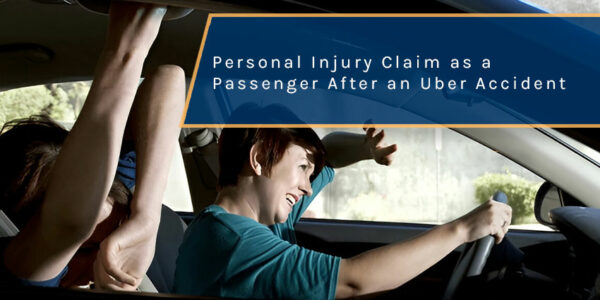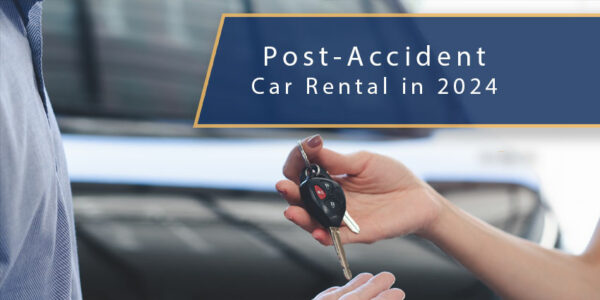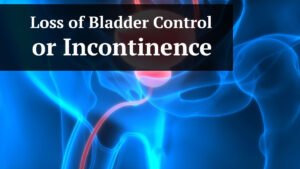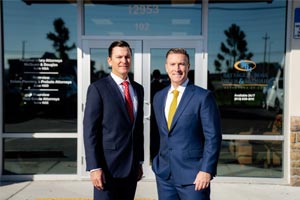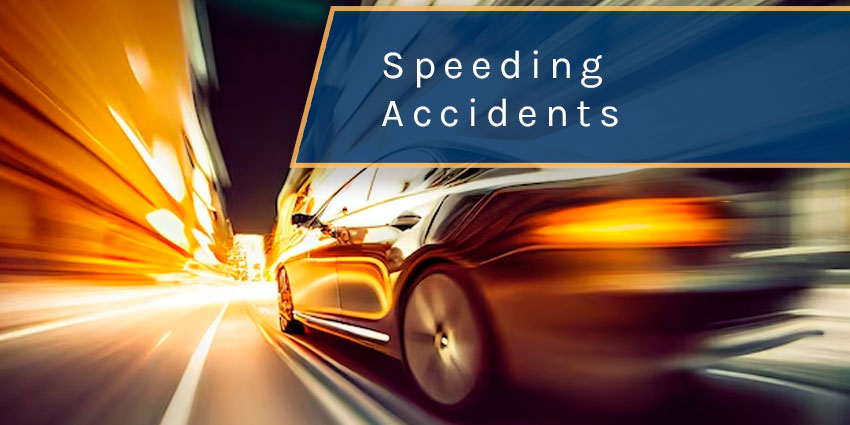
Speeding is one of the top contributors to car accidents and one of the most dangerous driving behaviors. Data shows that about 17% of all traffic crashes involve speeding and about a quarter of all traffic deaths also involve speeding.
In this article, we’ll review why speeding is so dangerous, potential injuries that can result from speeding, and how to stay safe on the roads.
An Overview of Speeding: It’s Doesn’t Just Mean Going Over the Posted Limit
Speeding is more than just going over the speed limit. Drivers need to adjust their speed to be suitable for the given conditions, so it’s possible for someone to be traveling within the posted limits but still be driving too fast for the given circumstances. For example, if it’s raining heavily and the visibility is reduced, drivers should use their logic and judgment skills to adjust their speed accordingly. Even if they aren’t technically speeding over the posted limit, they could very well be driving too fast for the given conditions.
Since Florida has diverse weather conditions that vary greatly, drivers need to exercise more caution and adjust their speeds to the conditions. Even if driving at 45 mph is completely safe and reasonable on a clear, sunny day, on a rainy day that could result in a disastrous collision.
According to the Governors Highway Safety Association, speeding is a factor in about 30% of all traffic fatalities per year. Just in 2020, there were over 11,000 deaths in car accidents where speeding was a contributing factor.
Again, speeding is not limited to going over the speed limit but is a matter of sound judgment. Here are some scenarios where a driver needs to adjust their speed to ensure they aren’t going too fast for the given conditions:
- Where there is reduced visibility (i.e., nighttime, fog or smoke)
- Hours when the sun causes a lot of glare
- During highly congested traffic hours
- If there are poorly maintained roads or curving roads
- Where there are pedestrians and crosswalks
- Anytime there is debris in the roadway, especially after a hurricane
Under Florida law, all drivers are required to follow the posted speed limits. Furthermore, Florida law enforces “absolute speeds limits” which doesn’t give driver’s much leeway. Absolute speed limits in St. Petersburg are 65 mph or less on highways and 25 mph or less in residential or business zones.
In addition to absolute speed limits, St. Petersburg also enforces basic speeding laws, which require drivers to exercise prudent and reasonable caution while driving. Meaning, they should use their own sound judgment to drive at a safe speed. If you’re going too fast for the current conditions, you can get a ticket, even if you weren’t technically going over the posted limit. Speeding in St. Petersburg can result in fines and other penalties, with harsher consequences for speeding in school and construction zones or causing bodily injury to others.
Common Reasons Why Drivers Speed in St. Petersburg, Florida
Speeding accidents are preventable. Even though speed is a controllable factor that everyone can safely adjust, speeding accidents still happen at an alarming rate. So why are so many people speeding even when they know it’s dangerous? Although There is no reason that makes speeding appropriate, there are some common reasons that prompt drivers to drive too fast:
- They’re late
- They lack experience on the road
- For an adrenaline rush
- Out of habit
- Drunk driving
- Being unaware of the speed limit
Speeding Is Dangerous for Several Reasons
Understanding why speeding is dangerous may encourage drivers to think twice before driving too fast. Here’s why speeding is dangerous:
- Speeding drivers have less time to react and avoid unexpected or abrupt hazards. At higher speeds, drivers only have a split second to make decisions. If there is an obstacle in the road or a pedestrian suddenly runs out into the road, there’s very little time to react and slam on the brakes. This is often what causes-rear end collisions – when the rear driver doesn’t have enough time to stop and hit the front car.
- Thinking distance and braking distance are both reduced at higher speeds. Namely, the actual time it takes to stop a car is the time it takes for a driver’s brain to process it and the actual time for them to react and hit the brakes. For instance, at 40 mph a car needs at least 120 feet to make a complete stop, but that distance doubles when you only add 20mph. So, a cat traveling at 60mph needs 240 feet to make a complete stop.
- Basic physics. Collision forces are more deadly at higher speeds. In other words, the faster you’re driving, the more kinetic energy you have and the more force is exerted into the crash. Even slight increases in speed Can exponentially worsen crash outcomes.
- Safety devices are less effective in high speed collisions. While safety features like seatbelts and airbags do save lives, at higher speeds, they cause damage too. For accidents occurring at extreme speeds, some safety features may not work at all.
Potential Injuries From Speeding Accidents
High speed crashes dramatically increase the potential for fatalities and catastrophic injuries. Speeding accidents frequently result in the following injuries:
- Broken bones – broken bones occur more frequently in high speed crashes, especially in rollover accidents or other types of severe crashes with very high impact. Chest, collarbone, rib, arm, hand, and legs are the most common types of broken bones in car accidents.
- Whiplash – a common yet disruptive neck injury that results from the rapid jerking motion of the neck. The impact of the accident causes the head to snap forward while the rest of the body is restrained by the seat belt, causing neck strain. Stronger crash impacts result in more severe whiplash, causing neck pain and spinal disc issues in severe cases.
- Traumatic brain injuries – car accidents are the second leading cause of TBI in the US. Symptoms of a TBI include headaches, dizziness, memory problems, difficulty breathing, and sensory loss.
- Spinal cord injuries – spinal cord injuries can cause paralysis and permanent disability.
- Soft tissue damage – these injuries include cuts, burns, abrasions and lacerations. They may not require medical treatment when they are the only injuries sustained, but usually occur with other injuries in high-speed collisions. Severe soft tissue damage can leave permanent scarring and disfigurement and consequently have a dramatic impact on one’s mental health.
After you get the necessary medical treatment and care needed to recover, contacting an experienced Florida personal injury attorney may be the most important step. This can help assure you get the compensation you’re entitled to for your injuries and give you the opportunity to hold the at-fault driver accountable.
How to Practice Safe Driving and Avoid the Need to Speed
One of the most powerful tools to prevent accidents is simply not speeding. Here are some tips to help you stay safe on the roads and avoid speeding:
- Wear your seatbelt. The National Highway Traffic Administration reports that nearly half of all drivers who die in a car accident were not wearing a seatbelt. High-speed crashes cause serious injuries and often result in death when occupants are ejected from the vehicle. The small act of wearing your seatbelt can save your life and significantly decrease your odds of dying, especially in a high-speed crash.
- Focus on driving and stay alert. Driving requires the driver to pay attention and make quick decisions. Limit distractions so you can avoid collisions with unexpected pedestrians, animals, or other objects that may suddenly appear in the road.
- Maintain a safe distance. Speeding drivers usually follow other cars too closely, often resulting in fender benders. Defensive driving is just as important as maintaining a safe speed, which means being aware of a speeding driver around you. If a speeding driver is tailgating you, move over and let them pass.
- Plan ahead so you can leave the house on time. Most of us speed when we are running late for a meeting, school, work, or some other important obligation. By taking a few extra minutes to prepare and leave on time, you can avoid the need to drive over the speed limit. Checking the weather to give yourself extra travel time in poor weather conditions is also a good idea.
- Put your cruise control to use. After a long day of work or several hours on the road, it’s almost inevitable to “zone out”. As a result, sometimes we end up speeding without even realizing it. Cruise control can help maintain a safe speed when you’re feeling fatigued or need to drive for extended periods.
- Switch it up. Taking a different route will force your brain to be more actively engaged in the task of driving and become more consciously aware.
Were You Injured by a Speeding Driver in St. Petersburg, Florida? Get Experienced Legal Help Now
High-speed accidents are much scarier than minor collisions at lower speeds. It can change the entire course of you and your family’s lives. When you’re stuck with severe damages after a speeding accident, you need legal counsel who understands the extent of your emotional and financial losses. Moreover, an attorney who knows how to calculate all your damages and seek the full financial award for all your damages can make a huge difference in the amount you win.
If you or your loved one was injured by a speeding driver, you may be eligible to seek financial damage compensation. However, Florida law does impose a time limit for which you can file a claim, so it’s best to act sooner rather than later.
Our Florida car accident lawyers want to help you and will fight hard to help protect your rights. Call us today for a free consultation.


















